The event is famed for its brightly coloured costumes and raucous celebrations. Several cultural events, such as “band launch fetes,” take place in the days leading up to Carnival Monday and Tuesday’s street parade. If the islanders are not celebrating it, it is believed that they are planning for it while remembering over the previous year’s event.The festival is traditionally connected with calypso music, which developed in the midst of suffering for enslaved West and Central Africans; nevertheless, Soca music has recently surpassed calypso as the most popular genre of music. The festival also includes mas costumes (also known as “mas”), stick fighting, and limbo competitions.

The Origin Of Carnival In Trinidad and Tobago
Carnival in Trinidad and Tobago began as a form of protest in the late eighteenth century. Following the Spanish Cedula of Population Edict of 1783, French planters, slaves, and emancipated people of colour from adjacent islands flocked to Trinidad. The French settlers, as well as emancipated persons of colour, hosted yearly masquerade parties shortly after their arrival. Slaves who were not allowed to participate in the masquerades decided to create their own Carnival in the slave quarters, where they had some freedom.

Canboulay’s date is significant in terms of the shaping of this type of identity expression because it was held just before Lent, a season during which one would abstain from all celebrations and rich foods such as meat, alcohol, and fats. As a result, carnival was a method to make up for the impending era of austerity by allowing people to express themselves freely. Participants were able to be as carefree as they wished thanks to the anonymity afforded by masks, costumes, and crowds.
Modern Day Carnival
Today’s Carnival celebrations are far more inclusive, with J’ouvert (derived from the French Jour Ouvert, literally meaning Open Day) signalling the commencement of the festivities. If you’re playing J’ouvert, get some rest before hitting the road again, since you’ve got a long two days of partying ahead of you!

There are many different forms of music and ways to “play mas.” The rhythm of Carnival is throbbing and pleasant, softly supporting you as you “chip” (dance) down the road on Carnival day, from traditional calypso and ex-tempo (songs made up on the spur of the moment) to popular soca beats. In order to bring the groove into the present day, many popular soca bands incorporate Jamaican reggae, dancehall, and dub sounds into their compositions, and sampling of pop and hip hop hits has also been on the rise. Even Latin vibes fit perfectly here, and everyone feels at ease! You can book a costume in any of a variety of bands to actually participate or “play mas.” There are the stripped-down bands like Burrokeets, where the goal is to have fun rather than to look pretty; then there are the “party” bands like Young Harts, Poison, Barbarossa, and Legends, which appeal to both fun-lovers and hard bodies.

Ready For The 2022 Carnival ?
The Port of Spain, Trinidad, will serve as the focal point for all activities during the Trinidad and Tobago Festival. However, in San Fernando, Chaguanas, Mayaro, Tobago, and Arima, there will be a slew of insane street parties. You can join in the fun anywhere in the area, but most festival-goers are aware that the most wild street parties will be in the adjacent towns and townships.
The Carnival of Trinidad will take place from February 25 to March 1, 2022.
Also Read : Nothing less than a paradise: Maldives





